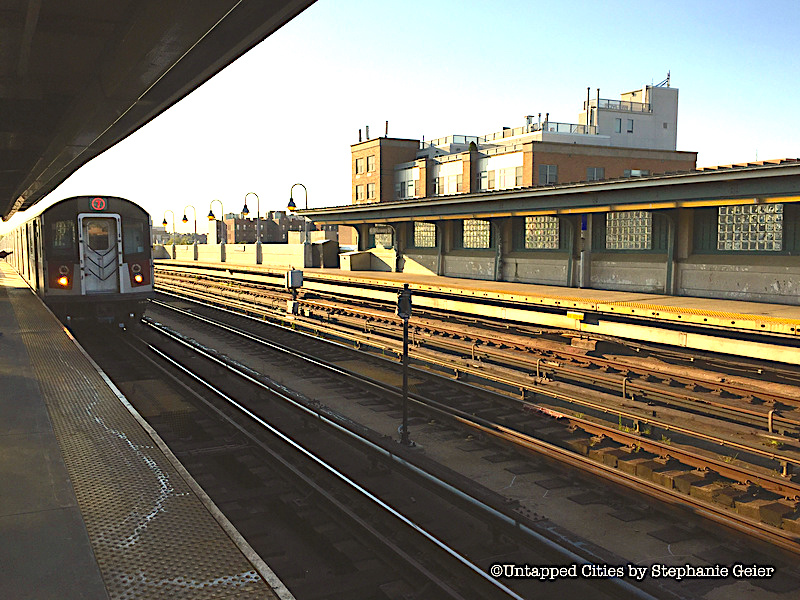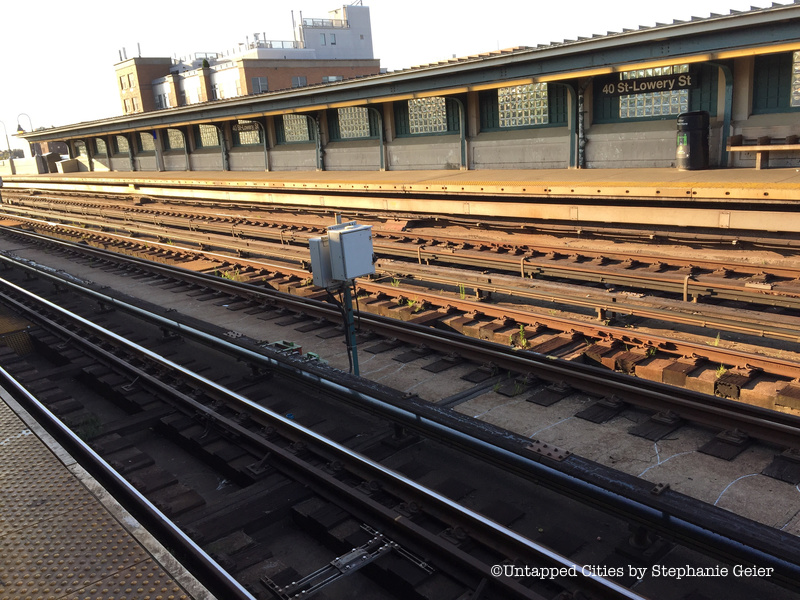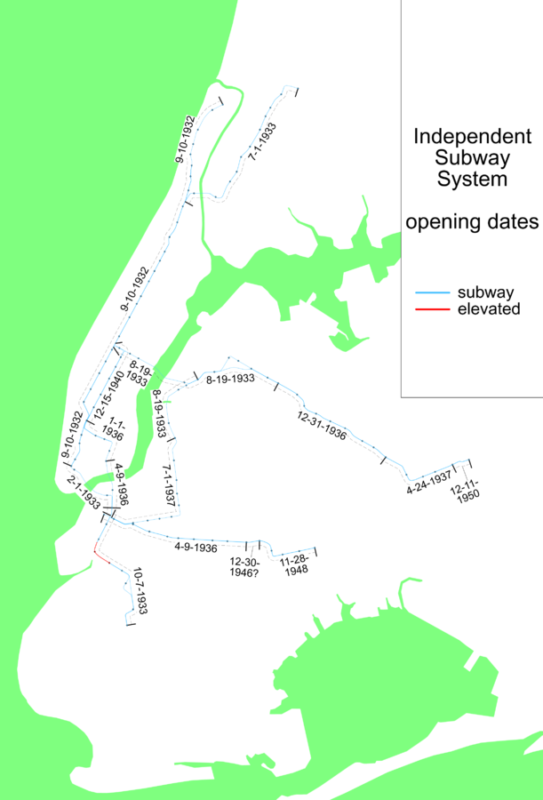
The New York City subway is full of secrets, from abandoned platforms to hidden tunnels. But there’s one secret about the subway that’s nearly impossible to scope out, even though it’s probably part of your daily commute. Did you know that numbered and lettered trains in New York City are different sizes? The reason has to do with the consolidation of the three railroad companies that once formed the MTA in the 1900s.
Originally, the MTA consisted of three railroad companies: the Interborough Rapid Transit Company (IRT), the Brooklyn-Manhattan Transit Corporation (BMT), and the city-owned Independent Rapid Transit Railroad (IND). However, they were all taken over and consolidated by the City in 1940—are their sizes haven’t changed.
The IRT, whose magnificent former powerhouse you can still see today, was a private organization managed by August Belmont. At the time, the City had an arrangement now called “Contract One,” in which the City kept the line’s ownership but delegated construction and operations to IRT. Construction on this subway started in 1900, with service beginning in 1904. The route followed the 4-5-6 train routes of today from City Hall to 42nd street, then verging west into the shuttle line we have today, with stops at Grand Central and Times (then “Longacre”) Square. Then, it turned north along the path of today’s 1-2-3 train lines until 145th street and Broadway.

At the same time, a Bronx route was created and at first linked to the 3rd Avenue El, and finally to the subway in 1905. Three years later, the line was extended via “Contract Two” to Atlantic Avenue, Brooklyn. In addition, the IRT leased the Manhattan Railway elevated lines for 999 years through their operational contract with the City.
The second company, the Brooklyn-Manhattan Transit (BMT) controlled the Brooklyn elevated lines starting in 1915.
In 1913, the city began working on the “Dual Contracts,” which allowed it to build more lines operated under the IRT and BMT. The lines were completed around 1920, with the new Flushing and Astoria lines having trains operated by both the IRT and BMT. NYC Subway explains:
“The Dual Contracts IRT lines were the Seventh Ave (south from Times Square) and Lexington Ave (north from Grand Central); the Jerome, White Plains Road and Pelham Bay Park branches in the Bronx, and the Brooklyn lines beyond Atlantic Ave. The BMT lines were the Broadway Subway and Nassau Street Subway in Manhattan, the 14th St.-Eastern District line from Manhattan to Brooklyn, and Fourth Ave., West End, and Culver lines in Brooklyn. Connections were also made to the company’s Sea Beach and Brighton Beach lines.”
Finally, the City established the Independent Subway (IND) in the 1920s as a way to create a subway that was “independent of manipulation by the IRT and BMT,” with the City’s Board of Transportation itself starting the operations. As the first subway system run by the city, the IND also had one elevated component over the Gowanus Canal. NYC Subway specifies:
“The IND lines were the 8th Avenue and 6th Avenue trunk lines in Manhattan, the Queens Boulevard subway in Queens, the Concourse subway in the Bronx, the Fulton Street subway in Brooklyn, the Brooklyn/Queens Crosstown, and the line in Brooklyn via Smith/9th Sts. to Church Avenue. Certain IND lines underpinned existing IRT and BMT elevated lines with the intention of eventually replacing them.”
 Timeline of the IND’s opening dates. Image via Wikimedia Commons user SPUI
Timeline of the IND’s opening dates. Image via Wikimedia Commons user SPUI
In 1940, after the BMT and IRT went bankrupt, the City took them over. Most of the elevated lines were closed by then, and a gradual “unification” occurred, as shown by the creation of free transfer points between divisions in 1948, as well as a smaller number of points running between IND and BMT lines in 1954. For instance, the Chrystie Street connection linked the BMT’s Manhattan Bridge lines with the IND’s Sixth Avenue lines.
In 1953, the state created the New York City Transit Authority, now the MTA New York City Transit, as a separate public organization to operate and manage all subway, bus, and trolleys owned by the city.
On paper, the city no longer uses the names “IND, BMT, and IRT. This is because in 1967, these subways became the “A Division” (aka IRT lines), “B-1 Division” (BMT lines), and “B-2 Division” (IND lines). However, the occasional long time New Yorker or subway operator will occasionally use the term for the sake of nostalgia, or perhaps to show off their expertise.
Today, BMT and IND trains are longer and wider than those from the IRT lines. Accordingly, a BMT/IND train also can’t fit into a tunnel made for IRT trains. However, an IRT train is able to fit into a BMT/IND tunnel, although it is not safe due to its narrower size.
Here’s a list that matches current subway lines with their old rail companies (via NYC Subway). Notice that all the numbered trains were operated by IRT, and are thus narrower than lettered trains, which were operated under IND and BMT.
- 1,2,3,4,5,6,7 Grand Central Shuttle: IRT
- A: IND from 207th Street to the tunnel portal between Grant Avenue and 80th Street/Hudson Street.
- B: IND from 205th Street to Broadway-Lafayette. BMT from the Manhattan Bridge to Coney Island.
- C: IND from 168th Street to Euclid Ave.
- D: IND from 205th Street to Broadway-Lafayette. BMT from the Manhattan Bridge to Coney Island.
- E: IND from Van Wyck Blvd. to World Trade Center.
- F: IND from 179th to Church Ave. tunnel portal. BMT from Ditmas Ave. to Coney Island.
- G: IND along entire length.
- J/Z: BMT from 121st St. to Broad Street.
- L: BMT along entire length.
- M: BMT along entire length.
- N: BMT along entire length.
- Q: IND from 47th-50th Streets to Broadway-Lafayette. BMT from Manhattan Bridge to Brighton Beach.
- R: BMT from 60th Street Tunnel to 95th Street.
- S (Franklin Shuttle): BMT along entire length.
So there you have it. The trains from the different lines aren’t the same sizes. Although it’s a small secret compared to the many others the subway holds, it’s a fact that might be fun to ponder the next time you switch between lettered and numbered trains!
Next, read The Top 10 Secrets of the NYC Subway and 12 of NYC’s Lost Subway and Rail Lines.






